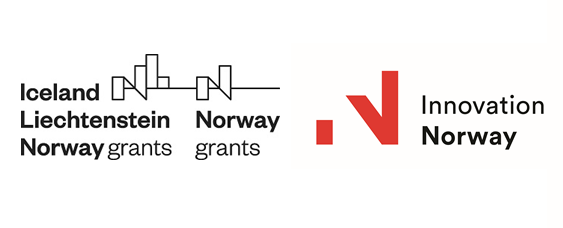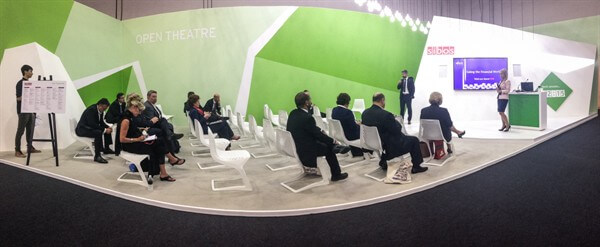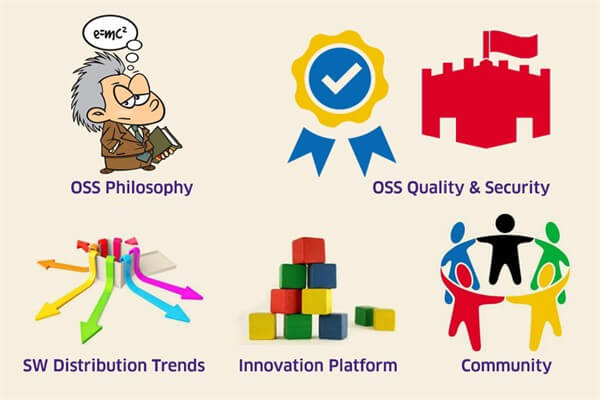Open source software, once just the domain of technology hobbyists, is expanding its footprint or, how some people dare put it, is “eating the world”. That’s why, this year at Sibos in Singapore we started the discussion about Banking On Open Source Technologies (BOOST), about creating and sharing software applications and related knowledge, in line with open source culture, about innovation through shared knowhow and collaboration and about bringing key inventions into established financial systems.
We have ignited an in depth conversation on this topic during the “Eating the Financial World” session in Open Theatre One on Monday at 12:15. And we want to bring you on board the deep dive we took into the hidden truths of banking software, how this is changing and how it impacts all collateral sides of the business.
Marc Andreessen’s 2011 proclamation that software is eating the world takes on new significance in light of IDC’s prediction that mobile, cloud, social and big data technologies will disrupt firms in every industry. Everybody has a big appetite and we truly believe that OSS will have a huge bite, that open sourcing is an irreversible trend even in the software industry. Probably the appetite is not as high in the financial world as it is in other areas or as it should be. That is why it is worth having a closer look at five topics related to open-source software, which contribute to having a good overview about how OSS can very well cater for the needs of the banking industry, offering the same quality and security as traditionally licensed software. Moreover, OS products give users control over the software they adopt, more transparency and an excellent platform for innovation and collaboration.
Open Source philosophy
The main principles of OSS are free cultural sharing and cooperation in non-differentiating areas. Open source software is an act of creativity. The culture of sharing in open source is our way forward, because we believe that by collaborating with the brainpower of an entire community of professionals that share the same values, we can deliver the best results.
Software distribution trends
Many headlines nowadays announce that public authorities support the adoption of open source in favor of enterprise software. For example the Italian government issued the final rules in implementing a change to procurement law that now requires all public administrations in the country to first consider re-used or free software before committing to proprietary licenses. Government institutions, healthcare and education systems are already looking into the possibility of adopting open source software not only at infrastructure level to reduce costs, but also at application layer and beyond.
According to Gartner, open source software will be included in mission-critical software portfolios of virtually all Global 2000 enterprises by 2016.
Allevo decided to change its business model and started publishing the source code of its application for processing financial transactions, FinTP, under the GPL v3 license. In this new frame the customer benefits from a technology that drives cost reduction and conveys full control over the source code of the application. This model also eliminates the common vendor lock-in dependence and empowers the users with access to a transparent product development process and transparent product audit.
OSS quality & OSS security
There is a never-ending debate going on regarding software quality and security – open source or proprietary.
Team skills and expertise in various areas, tools (internal developer tools, work item tracking, source control systems, testing automation), experience, timeline, processes and workflow are what define the quality of a software product. The quality of the software is not worse or better than the community joint forces can deliver – most people claim better quality, security and scalability.
Moreover, both delivering open source and closed source solutions are subjected to the same security threats from a technical point of view. Each of the security vulnerabilities have to be contained through coherent management and control over the software development and deployment lifecycle processes. These processes need to be adapted to the type of distribution model – open source and closed source. In our opinion vulnerabilities that come from community contributions have a risk score as low as contributions in closed source applications.
Regarding transparency – having a closed application does not mean that vulnerabilities do not exist or that they cannot be exploited. It just means that they are less in the open. In open source, for any given problem, there is the possibility for a large number of ‘eyeballs’ to be looking at it. In a closed-source project, the maximum number of people looking at any given problem is always limited by the total number of employed developers.
Innovation Platform (and Coopetition)
An open source project can definitely become an innovation platform, supporting new business, but at the same time a standardization (including semantic) platform for operations.
Since changing our distribution model and publishing our proprietary application into open source, we identified several opportunities to deliver new solutions.
FinTP is positioned in the back-office of a bank and external market infrastructures – SWIFT Network, proprietary networks. On top of this financial middleware several operational features were added; features like duplicate detection, transaction filtering, accounting reconciliation, treasury flows, liquidity reporting, competitive alerts and so on.
But let’s give a couple of examples that go beyond the general use of our application. A micro-financing institution in Uganda selected our application to integrate new disbursement channels by connecting to mobile money transfer operators. This way, they can give loans to their customers and receive repayments via mobile phones, eliminating the need of working with cash and of asking their customers to come to their branches. Another example is the possibility to automate the payment flows for wage payments of Public Institutions.
What about the possibility of cooperation between competitors? Coopetition (cooperation & competition) is the new business paradigm that rises across industries, at global scale. The diversity of profiles and interests of individuals and companies extends the use of our source code to serve various purposes. Publishing developments committed by others, even by competitors, enlarges the footprint of the application and generates new cooperation areas.
Another argument for going forward comes from recent studies, which underline that the financial services industry has started to look into the possibility of adopting open source software at application layer. The argument is that open source enables companies to collaboratively develop non-differentiating software for processing transactions or regulatory compliance – the plumbing and framework all financial institutions need. We believe that the back-office area of banks and the processing of transactions is performed very similarly in most financial institution. Consequently, this is not an area where there should be competition. Using open source software allows them to focus on other areas that can differentiate them and attract customers – services offered to people and businesses.
Community
Behind any open source product there is a community of people having different roles and benefits. By comparison, for a closed-source product, the community is comprised of the provider and the client base.
In open source communities, the benefits are different for every member profile, but the essence is that everybody is involved because of having a shared interest and acts as an entrepreneur – having ideas, initiatives and the freedom to act accordingly to own beliefs.
When asked why corporations engaged with OSS communities, cost reduction remanded the top response (61%), but gaining competitive advantage came in second (45%), and for companies over 1000 employees, influencing a project’s direction was the third most popular answer.
FOSS – Future OSS: The senior open source strategist from Samsung states that they both use open source technology in their products and contribute to open source. This way, they make sure they can influence the development track of the projects. In his view, in order to be successful and have competitive advantage when consuming open source, one needs to collaborate with others to build reliable projects. Helping projects grow gives the possibility to free up engineering resources to work on things that are strategic, rather than work on things which are commodity.
More about this at Allevo’s stand N49 while at Sibos or any other time. Just drop us an email.











